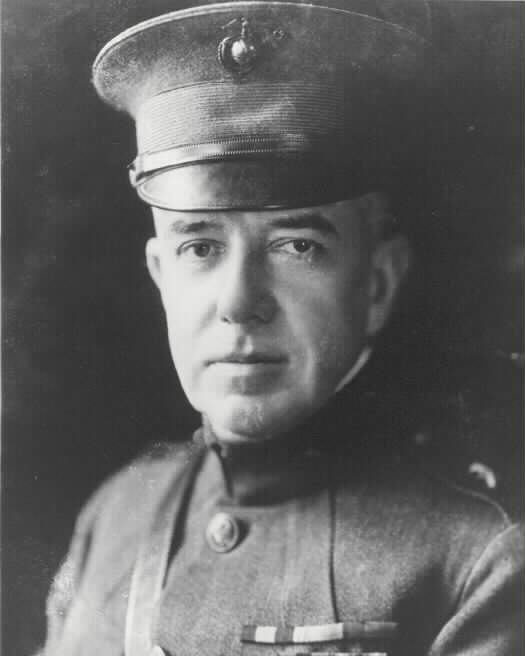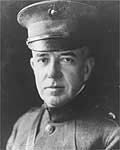On December 1, 1936, Major General John H. Russell, U. S. Marine Corps, was retired from active duty, having attained the age of 64 years on the 14th of November. That closed the active service of a distinguished officer who throughout his career from second lieutenant to the sixteenth Major General Commandant.
General Russell was born in California on November 14, 1872. He was appointed to the United States Naval Academy by President Cleveland in May, 1888. He was graduated from the Academy in June, 1892, and after two years at sea passed his final examinations and was transferred to the Marine Corps as a second lieutenant on July 1, 1894.
Upon appointment as an officer in the Marine Corps he attended the School of Application at the Marine Barracks, Washington, D.C., graduating in 1895. He was retained for another year at the School to conduct a class for non-commissioned officers.
Promotion to successive grades in the Marine Corps followed: first lieutenant, August 10, 1898; captain, March 3, 1899; major, June 6, 1906; lieutenant colonel August 29, 1916; colonel, March 26, 1917; brigadier general, January 1, 1922; major general, September 1,1933, and Major General Commandant on March 1, 1934.
To mention but a few of the outstanding tours of duty performed by General Russell during his service in the Marine Corps the following are selected:
In 1896, he joined the USS MASSACHUSETTS, North Atlantic Squadron, serving on board until after the Spanish American War. The Commanding Officer of the vessel addressed a letter to the Secretary of the Navy commenting favorably on the conduct and performance of duty of John H. Russell in action and recommending recognition thereof by the Navy Department.
He next performed duty on Guam and upon his return to the United States was placed in charge of the School of Application for Officer at the Marine Barracks, Washington, D.C. Following this tour of duty and also duty at several navy yards, he was ordered to command the Marine Detachment, USS OREGON, remaining on board from September, 1902 to March, 1904. His next shore duty was in command of the school for young officers established at the Marine Barracks, Annapolis, Maryland. In 1906, he was transferred to the Marine Barracks, Naval Station, Honolulu, T. H. From that duty he was ordered to Camp Elliott, Panama Canal Zone, to command the Marines at that station.
In September, 1908, he joined the Naval War College, Newport, Rhode Island, for duty as a member of the Staff of that college, remaining there until 1910, and it was during this tour of service that the “applicatory method” of instruction was put into effect.
He commanded the Marine Detachment, American Legation, Peking, China, from November 14, 1910 to April 30, 1913. The change in the Chinese government from and empire to a republic, which took place during this period, and the attendant disorders in and around Peking made this tour of duty particularly interesting and difficult.
Upon his return to the United States he was assigned duty in the Office of Naval Intelligence, Navy Department, where he served until 1917, with the exception of a tour of duty (temporary) from April 30 to December 5, 1914, commanding the Second Battalion, Third Regiment, U. S. Marines at Vera Cruz, Mexico, being detached to the U.S. Army during the period.
Early in March, 1917, he assumed command of the Third Regiment, with headquarters in Santo Domingo City, Dominican Republic, and within a short period of time he was detached and ordered to command the Fourth Regiment of Marines with headquarters at Santiago de los Caballeros, where he remained until October, 1917, when he was detached and ordered to the Republic of Haiti to command the Marine Brigade serving in that country. He served in that capacity until December 7, 1918.
His repeated efforts for detachments to serve in France were finally successful, but delay in arrival of his relief in Haiti did not permit transfer from Port-au-Prince until after the Armistice was signed.
On arrival in Washington he was ordered to duty in command of the “Planning Section” at Headquarters Marine Corps and served in that capacity until September, 1919, when he again was ordered to duty in Haiti to command the First Brigade Marines, serving in that capacity until February, 1922, when, upon the unanimous recommendation to the President by the U. S. Senate Committee that had been investigating affairs in Haiti, he was appointed American High Commissioner to Haiti with the rank of Ambassador Extraordinary. General Russell served with distinction in Haiti as High Commissioner until November, 1930.
Upon his return to the United States he was assigned to duty as Commanding General, Marine Corps Base, San Diego, California, and was transferred to command the Marine Barracks, Quantico, Virginia in December, 1931. He was detailed to Marine Corps in February, 1933. General Russell was appointed Commandant of the Marine Corps on March 1, 1934, and remained on that duty until his retirement.
In addition to numerous letters of commendation on his excellent performance of duty during his long and varied career, General Russell has been awarded the Distinguished Service Medal; Navy Cross; Haitian Medaille; West Indies (Sampson) Medal; Spanish Campaign Medal; Expeditionary Medal with West Indies Clasp; and the Haitian Campaign Medal.
General Russell died in Coronado, California, March 6, 1947. He was interred in the Arlington National Cemetery. His wife, Mable Howard Russell (December 22, 1878 – March 31, 1967) is buried with him in Section 7.

Biography courtesy of the United States Marine Corps
Michael Robert Patterson was born in Arlington and is the son of a former officer of the US Army. So it was no wonder that sooner or later his interests drew him to American history and especially to American military history. Many of his articles can be found on renowned portals like the New York Times, Washingtonpost or Wikipedia.
Reviewed by: Michael Howard

